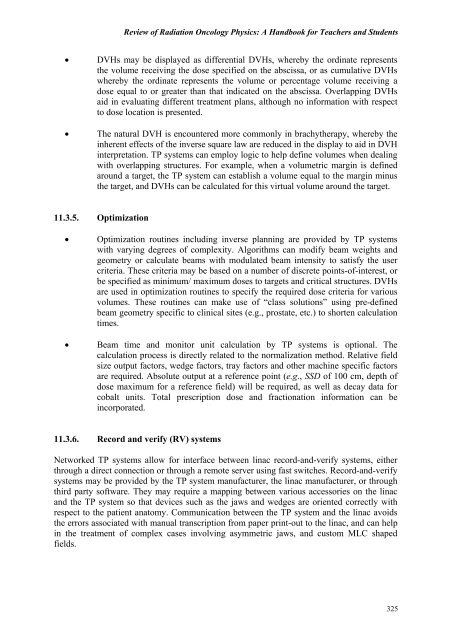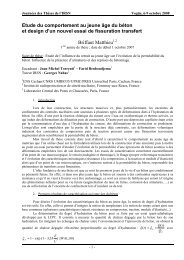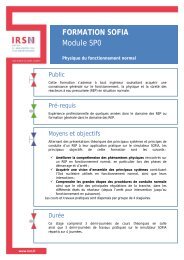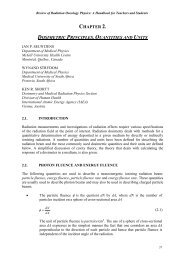Review of Radiation Therapy Physics: A syllabus for teachers ... - IRSN
Review of Radiation Therapy Physics: A syllabus for teachers ... - IRSN
Review of Radiation Therapy Physics: A syllabus for teachers ... - IRSN
You also want an ePaper? Increase the reach of your titles
YUMPU automatically turns print PDFs into web optimized ePapers that Google loves.
<strong>Review</strong> <strong>of</strong> <strong>Radiation</strong> Oncology <strong>Physics</strong>: A Handbook <strong>for</strong> Teachers and Students• DVHs may be displayed as differential DVHs, whereby the ordinate representsthe volume receiving the dose specified on the abscissa, or as cumulative DVHswhereby the ordinate represents the volume or percentage volume receiving adose equal to or greater than that indicated on the abscissa. Overlapping DVHsaid in evaluating different treatment plans, although no in<strong>for</strong>mation with respectto dose location is presented.• The natural DVH is encountered more commonly in brachytherapy, whereby theinherent effects <strong>of</strong> the inverse square law are reduced in the display to aid in DVHinterpretation. TP systems can employ logic to help define volumes when dealingwith overlapping structures. For example, when a volumetric margin is definedaround a target, the TP system can establish a volume equal to the margin minusthe target, and DVHs can be calculated <strong>for</strong> this virtual volume around the target.11.3.5. Optimization• Optimization routines including inverse planning are provided by TP systemswith varying degrees <strong>of</strong> complexity. Algorithms can modify beam weights andgeometry or calculate beams with modulated beam intensity to satisfy the usercriteria. These criteria may be based on a number <strong>of</strong> discrete points-<strong>of</strong>-interest, orbe specified as minimum/ maximum doses to targets and critical structures. DVHsare used in optimization routines to specify the required dose criteria <strong>for</strong> variousvolumes. These routines can make use <strong>of</strong> “class solutions” using pre-definedbeam geometry specific to clinical sites (e.g., prostate, etc.) to shorten calculationtimes.• Beam time and monitor unit calculation by TP systems is optional. Thecalculation process is directly related to the normalization method. Relative fieldsize output factors, wedge factors, tray factors and other machine specific factorsare required. Absolute output at a reference point (e.g., SSD <strong>of</strong> 100 cm, depth <strong>of</strong>dose maximum <strong>for</strong> a reference field) will be required, as well as decay data <strong>for</strong>cobalt units. Total prescription dose and fractionation in<strong>for</strong>mation can beincorporated.11.3.6. Record and verify (RV) systemsNetworked TP systems allow <strong>for</strong> interface between linac record-and-verify systems, eitherthrough a direct connection or through a remote server using fast switches. Record-and-verifysystems may be provided by the TP system manufacturer, the linac manufacturer, or throughthird party s<strong>of</strong>tware. They may require a mapping between various accessories on the linacand the TP system so that devices such as the jaws and wedges are oriented correctly withrespect to the patient anatomy. Communication between the TP system and the linac avoidsthe errors associated with manual transcription from paper print-out to the linac, and can helpin the treatment <strong>of</strong> complex cases involving asymmetric jaws, and custom MLC shapedfields.325
















